
Constantinople became the capital of the Roman Empire during the reign of Constantine the Great in 330. Following the collapse of the Western Roman Empire in the late 5th century, Constantinople remained the capital of the Eastern Roman Empire, the Latin Empire (1204–1261), and the Ottoman Empire (1453–1922). Following the Turkish War of Independence, the Turkish capital then moved to Ankara. Officially renamed Istanbul in 1930, the city is today the largest city in Europe, straddling the Bosporus strait and lying in both Europe and Asia, and the financial centre of Turkey.

Pedanius Dioscorides, "the father of pharmacognosy", was a Greek physician, pharmacologist, botanist, and author of De materia medica, a 5-volume Greek encyclopedia about herbal medicine and related medicinal substances, that was widely read for more than 1,500 years. For almost two millennia Dioscorides was regarded as the most prominent writer on plants and plant drugs.
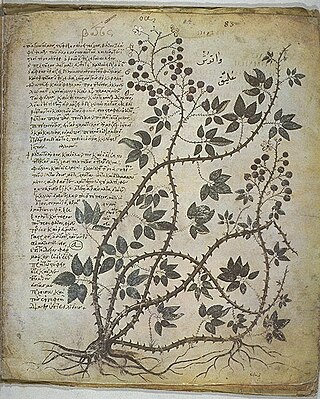
Materia medica is a Latin term from the history of pharmacy for the body of collected knowledge about the therapeutic properties of any substance used for healing. The term derives from the title of a work by the Ancient Greek physician Pedanius Dioscorides in the 1st century AD, De materia medica, 'On medical material'.
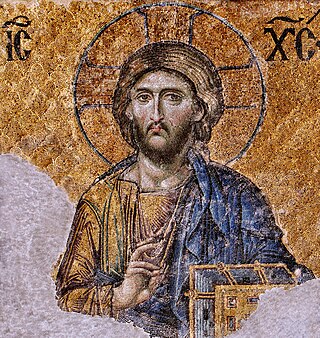
Byzantine art comprises the body of artistic products of the Eastern Roman Empire, as well as the nations and states that inherited culturally from the empire. Though the empire itself emerged from the decline of western Rome and lasted until the Fall of Constantinople in 1453, the start date of the Byzantine period is rather clearer in art history than in political history, if still imprecise. Many Eastern Orthodox states in Eastern Europe, as well as to some degree the Islamic states of the eastern Mediterranean, preserved many aspects of the empire's culture and art for centuries afterward.
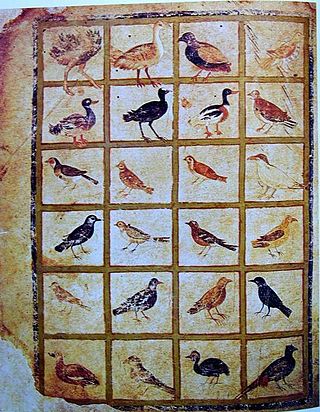
The Vienna Dioscurides or Vienna Dioscorides is an early 6th-century Byzantine Greek illuminated manuscript of an even earlier 1st century AD work, De materia medica by Pedanius Dioscorides in uncial script. It is an important and rare example of a late antique scientific text. After residing in Constantinople for just over a thousand years, the text passed to the Holy Roman Emperor in Vienna in the 16th century, a century after the city fell to the Ottoman Empire.
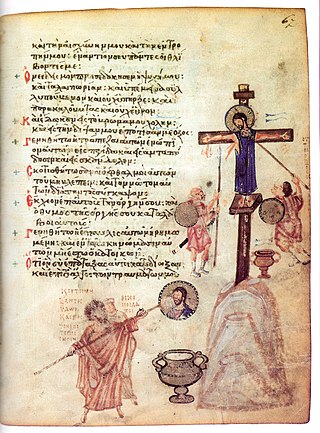
Chludov Psalter is an illuminated marginal Psalter made in the middle of the 9th Century. It is a unique monument of Byzantine art at the time of the Iconoclasm, one of only three illuminated Byzantine Psalters to survive from the 9th century.

The Naples Dioscurides, in the Biblioteca Nazionale, Naples, is an early 7th-century secular illuminated manuscript Greek herbal. The book has 172 folios and a page size of 29.7 x 14 cm and the text is a redaction of De Materia Medica by the 1st century Greek military physician Dioscorides, with descriptions of plants and their medicinal uses. Unlike De Materia Medica, the text is arranged alphabetically by plant.
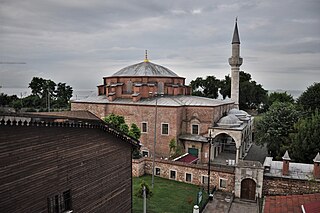
The Little Hagia Sophia mosque, formerly the Church of Saints Sergius and Bacchus, is a former Greek Orthodox church dedicated to Saints Sergius and Bacchus in Constantinople, built between 532 and 536, and converted into a mosque during the Ottoman Empire.

Neolithic artifacts, uncovered by archeologists at the beginning of the 21st century, indicate that Istanbul's historic peninsula was settled as far back as the 6th millennium BCE. That early settlement, important in the spread of the Neolithic Revolution from the Near East to Europe, lasted for almost a millennium before being inundated by rising water levels. The first human settlement on the Asian side, the Fikirtepe mound, is from the Copper Age period, with artifacts dating from 5500 to 3500 BCE. In the European side, near the point of the peninsula (Sarayburnu) there was a settlement during the early 1st millennium BCE. Modern authors have linked it to the possible Thracian toponym Lygos, mentioned by Pliny the Elder as an earlier name for the site of Byzantium.

Anicia Juliana was a Late Antique Roman imperial princess, wife of the magister militum of the eastern Roman empire, Areobindus Dagalaiphus Areobindus, patron of the great Church of St Polyeuctus in Constantinople, and owner of the Vienna Dioscurides. She was the daughter of the Roman emperor Olybrius and his wife Placidia, herself the daughter of the emperor Valentinian III and Licinia Eudoxia, through whom Anicia Juliana was also great-granddaughter of the emperor Theodosius II and the sainted empress Aelia Eudocia. During the rule of the Leonid dynasty and the rise of the later Justinian dynasty, Anicia Juliana was thus the most prominent member of both the preceding imperial dynasties, the Valentinianic dynasty established by Valentinian the Great and the related Theodosian dynasty established by Theodosius the Great.

Botanical illustration is the art of depicting the form, color, and details of plant species. They are generally meant to be scientifically descriptive about subjects depicted and are often found printed alongside a botanical description in books, magazines, and other media. Some are sold as artworks. Often composed by a botanical illustrator in consultation with a scientific author, their creation requires an understanding of plant morphology and access to specimens and references.

The Menologion, Menologium, or Menology of Basil II is an illuminated manuscript designed as a church calendar or Eastern Orthodox Church service book (menologion) that was compiled c. 1000 AD for the Byzantine Emperor Basil II. It contains a synaxarion, a short collection of saints' lives, compiled at Constantinople for liturgical use and around 430 miniature paintings by eight different artists. It was unusual for a menologion from that era to be so richly painted. It currently resides in the Vatican Library . A full facsimile was produced in 1907.
John Chortasmenos was a Byzantine monk and bishop of Selymbria, who was a distinguished bibliophile, writer, and teacher.
The Baghdad School, also known as the Arab school, was a relatively short-lived yet influential school of Islamic art developed during the late 12th century in the capital Baghdad of the ruling Abbasid Caliphate. The movement had largely died out by the early 14th century, five decades following the invasion of the Mongols in 1258 and the downfall of the Abbasids' rule, and would eventually be replaced by stylistic movements from the Mongol tradition. The Baghdad School is particularly noted for its distinctive approach to manuscript illustration. The faces depicted in illustrations were individualized and expressive, with the scenes often highlighting realistic features of everyday life from the period. This stylistic movement used strong, bright colors, and employed a balanced sense of design and a decorative quality, with illustrations often lacking traditional frames and appearing between lines of text on manuscript pages.

The Physician Preparing an Elixir is a miniature on a folio from an illustrated manuscript copy, now in the Metropolitan Museum of Art in New York of De Materia Medica, a large herbal or work on the (mostly) medical uses of plants originally written by the ancient Greco-Roman physician, Pedanius Dioscorides, in the first century AD. This page of the manuscript, dated 1224 AD, is made from paper, sized 24.8 cm wide and 33.2 cm long, and is decorated by opaque watercolor, ink, and gold detailing. It is visually split into three horizontal portions from the top of the page to the bottom; the top of the page is dominated by two lines of Arabic script, followed by the image and then five more lines of text in Arabic. The writing below the image is predominantly black with the exception of one line, which is written in red ink and is therefore highlighted to the viewer. The page is usually not on display.

Theophrastus's Enquiry into Plants or Historia Plantarum was, along with his mentor Aristotle's History of Animals, Pliny the Elder's Natural History and Dioscorides's De materia medica, one of the most important books of natural history written in ancient times, and like them it was influential in the Renaissance. Theophrastus looks at plant structure, reproduction and growth; the varieties of plant around the world; wood; wild and cultivated plants; and their uses. Book 9 in particular, on the medicinal uses of plants, is one of the first herbals, describing juices, gums and resins extracted from plants, and how to gather them.

De materia medica is a pharmacopoeia of medicinal plants and the medicines that can be obtained from them. The five-volume work was written between 50 and 70 CE by Pedanius Dioscorides, a Greek physician in the Roman army. It was widely read for more than 1,500 years until supplanted by revised herbals in the Renaissance, making it one of the longest-lasting of all natural history and pharmacology books.
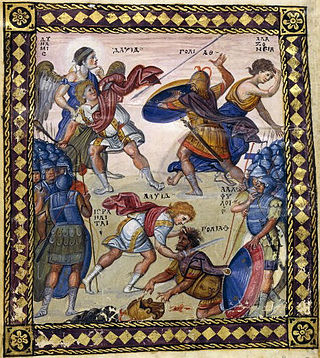
Byzantine illuminated manuscripts were produced across the Byzantine Empire, some in monasteries but others in imperial or commercial workshops. Religious images or icons were made in Byzantine art in many different media: mosaics, paintings, small statues and illuminated manuscripts. Monasteries produced many of the illuminated manuscripts devoted to religious works using the illustrations to highlight specific parts of text, a saints' martyrdom for example, while others were used for devotional purposes similar to icons. These religious manuscripts were most commissioned by patrons and were used for private worship but also gifted to churches to be used in services.
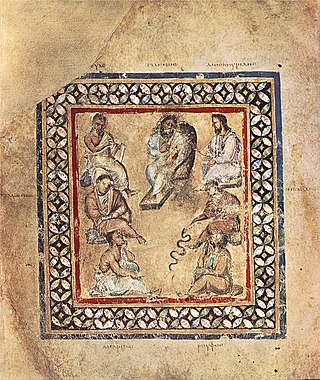
Crateuas, also known as Cratevas (Latin), Krateuas, or Kratevas, was a Greek doctor and pharmacologist. He was distinguished from others of the same name by the epithet "Rootpicker" or "Rhizotomist" after the Greek name of his principle work, the Herbology.

The Kokkinobaphos Master is the conventional name by which modern historians call a master miniaturist active in Constantinople, the capital of the Byzantine Empire, during the 12th century.
















